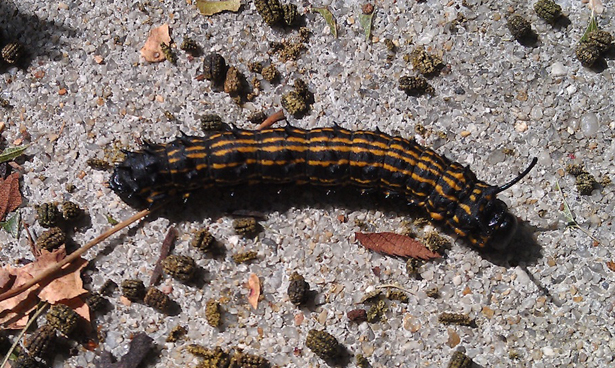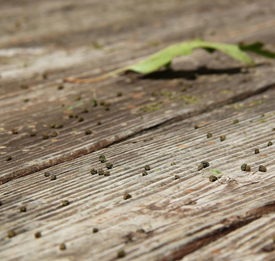Nature in Your Backyard: Very Hungry Caterpillars

[Editor’s Note: This is a guest post by Holly Menninger, director of public science in NC State’s Your Wild Life program. The post originally ran on the Your Wild Life blog.]
Over the weekend, our friend and veteran NC State science newsman Matt Shipman took a barefooted step out onto his back porch to enjoy a little late summer fresh air and sunshine.

His leisurely afternoon stroll ended with an abrupt OW!
Strewn across Matt’s deck was an array of small, crunchy pellets. They were dry and hard and big enough to hurt the undersides of his feet.
An English major in college, Matt thought it best to consult his better half, fisheries biologist Julia Ellis, to investigate this little mystery.
Julia looked up at the oak trees overhead and suspected an insect was at fault. She thought those little pellets looked suspiciously like frass – the term entomologists use to describe insect poop in polite company.
Yet Julia didn’t notice much damage to the leaves or branches overhead so she posited that whatever made these poo pellets must not have been too abundant.
A couple days later, Julia and Matt went back out onto their deck (with shoes on this time) and encountered a herd of 15 black and orange-striped caterpillars, providing further credence to Julia’s insect hunch.
After some online sleuthing, with later confirmation by NC State entomologist Steve Frank, Julia determined that orangestriped oakworms (Anisota senatoria) were responsible for all the frass.
According to Steve, people really notice this native species in late summer, near the end of the caterpillar’s larval development. That’s when they are fat, juicy eating-machines, chomping away on oak leaves and pooping out the fibrous leftovers. Steve suspected that the caterpillars Julia and Matt later found on their deck were probably just making their way down to ground-level so that they could pupate in the soil overwinter.
Curious to learn more about orangestriped oakworms? Head over to Steve’s EcoIPM blog to read more about them.
And remember, we’re always curious to learn more about the nature in your backyard. Drop us a line at yourwildlife@gmail.com and share your observations with us!
- Categories:


